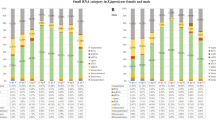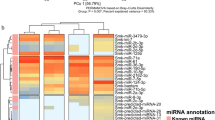Abstract
Rhipicephalus sanguineus is an ectoparasite of medical and veterinary significance, which can transmit a number of pathogens including Babesia canis, Ehrlichia canis, and Rickettsia conorii. MicroRNAs (miRNAs) are recognized as regulators in sex differentiation in dioecious species. We here investigated and compared the miRNA profiles of male and female adults of R. sanguineus by combining Solexa deep sequencing with bioinformatics platform and quantitative real-time PCR. A total of 11.88 and 16.09 million raw reads were obtained from male and female R. sanguineus, respectively. By mapping to the reference genome, 59 and 76 miRNA candidates from the female and male parasite were obtained, with 19 of each consistent with known Ixodes scapularis miRNAs deposited in the miRBase database. Besides, 51 miRNAs were shared by the two genders, and 8 and 25 were female and male specific, respectively. The number of predicted targets of the identified miRNAs ranged from 1 to 383 with an average of 176. Functional analysis showed that a number of predicted targets corresponded to transcription, splicing, and translation factors, elongation factors, and growth factors which were essential for the development of the parasite. Enrichment analysis revealed that some functions of the predicted targets were higher in female than in male, such as antioxidant and electron carrier. The present study firstly described the global profiling of miRNAs in male and female R. sanguineus and identified a number of gender-specific miRNAs, which are likely to participate in the sex differentiation/maintenance process and provide novel resources for better understanding of the biology of the parasite, and may further lead to effective control of the parasite and diseases it causes.



Similar content being viewed by others
References
Barker, S. C., & Murrell, A. (2004). Systematics and evolution of ticks with a list of valid genus and species names. Parasitology, 129, S15–S36.
Bartel, D. P. (2004). MicroRNAs: genomics, biogenesis, mechanism, and function. Cell, 116, 281–297.
Chen, C., Ridzon, D. A., Broomer, A. J., Zhou, Z., Lee, D. H., Nguyen, J. T., et al. (2005). Real-time quantification of microRNAs by stem–loop RT–PCR. Nucleic Acids Research, 33, e179-e179.
Chen, M. X., Ai, L., Xu, M. J., Zhang, R. L., Chen, S. H., Zhang, Y. N., et al. (2011). Angiostrongylus cantonensis: identification and characterization of microRNAs in male and female adults. Experimental Parasitology, 128, 116–120.
Dantas-Torres, F. (2008). The brown dog tick, Rhipicephalus sanguineus (Latreille, 1806) (Acari: Ixodidae): from taxonomy to control. Veterinary Parasitology, 152, 173–185.
Dantas-Torres, F. (2010). Biology and ecology of the brown dog tick, Rhipicephalus sanguineus. Parasites & Vectors, 3, 26.
Gilad, S., Meiri, E., Yogev, Y., Benjamin, S., Lebanony, D., Yerushalmi, N., et al. (2008). Serum microRNAs are promising novel biomarkers. PloS One, 3, e3148.
Jongejan F., & Uilenberg G. (2005). The global importance of ticks. Parasitology, 129, S3.
Kruger J., & Rehmsmeier M. (2006). RNAhybrid: microRNA target prediction easy, fast and flexible. Nucleic Acids Research, 34, W451–W454.
Li, R., Yu, C., Li, Y., Lam, T. W., Yiu, S. M., Kristiansen, K., & Wang J. (2009). SOAP2: an improved ultrafast tool for short read alignment. Bioinformatics, 25, 1966–1967.
Lim, L. P., Lau, N. C., Weinstein, E. G., Abdelhakim, A., Yekta, S., Rhoades, M. W., et al. (2003). The microRNAs of Caenorhabditis elegans. Genes & Development, 17, 991–1008.
Liu, Q., Tuo, W., Gao, H., & Zhu, X. Q. (2010). MicroRNAs of parasites: current status and future perspectives. Parasitology Research, 107, 501–507.
Livak, K. J., & Schmittgen, T. D. (2001). Analysis of relative gene expression data using real-time quantitative PCR and the 2− ΔΔCT method. Methods, 25, 402–408.
MacRae, I. J., Zhou, K., & Doudna, J. A. (2007). Structural determinants of RNA recognition and cleavage by Dicer. Nature Structural & Molecular Biology, 14, 934–940.
Mount, D. W. (2007) Using the basic local alignment search tool (BLAST). Cold Spring Harbor Protocols 2007, pdb. top17.
Rathjen, T., Nicol, C., McConkey, G., & Dalmay, T. (2006). Analysis of short RNAs in the malaria parasite and its red blood cell host. FEBS Letters, 580, 5185–5188.
Starega-Roslan, J., Krol, J., Koscianska, E., Kozlowski, P., Szlachcic, W. J., Sobczak, K., & Krzyzosiak, W. J. (2011). Structural basis of microRNA length variety. Nucleic Acids Research, 39, 257–268.
Walker, J. B., Keirans, J. E. & Horak, I. G. (2000). The genus Rhipicephalus (Acari, Ixodidae): a guide to the brown ticks of the world. ed. Cambridge University Press.
Wang, Z., Xue, X., Sun, J., Luo, R., Xu, X., Jiang, Y., et al. (2010). An “in-depth” description of the small non-coding RNA population of Schistosoma japonicum schistosomulum. PLoS Neglected Tropical Diseases, 4, e596.
Wang, J., Liu, X., Jia, B., Lu, H., Peng, S., Piao, X., et al. (2012). A comparative study of small RNAs in Toxoplasma gondii of distinct genotypes. Parasites and Vectors, 5.
Xu, M. J., Liu, Q., Nisbet, A. J., Cai, X. Q., Yan, C., Lin, R. Q., et al. (2010). Identification and characterization of microRNAs in Clonorchis sinensis of human health significance. BMC Genomics, 11.
Xu, M. J., Fu, J. H., Nisbet, A. J., Huang, S. Y., Zhou, D. H., Lin, R. Q., et al. (2013). Comparative profiling of microRNAs in male and female adults of Ascaris suum. Parasitology Research, 112, 1189–1195.
Xue, X., Sun, J., Zhang, Q., Wang, Z., Huang, Y. & Pan, W. (2008). Identification and characterization of novel microRNAs from Schistosoma japonicum. PloS One, 3, e4034.
Zuker, M. (2003). Mfold web server for nucleic acid folding and hybridization prediction. Nucleic Acids Research, 31, 3406–3415.
Acknowledgments
This work was supported in part by the National Key Basic Research Program (973 Program) of China (Grant No. 2015CB150300) and the Science Fund for Creative Research Groups of Gansu Province (Grant No. 1210RJIA006).
Author information
Authors and Affiliations
Corresponding authors
Electronic supplementary material
Additional file 1.
The best match target of miRNA of female and male Rhipicephalus sanguineus. (DOCX 19 kb)
Additional file 2.
Blast analysis to the targets of miRNAs of female Rhipicephalus sanguineus. (DOCX 56 kb)
Rights and permissions
About this article
Cite this article
Shao, CC., Xu, MJ., Chen, YZ. et al. Comparative Profiling of MicroRNAs in Male and Female Rhipicephalus sanguineus . Appl Biochem Biotechnol 176, 1928–1936 (2015). https://doi.org/10.1007/s12010-015-1688-x
Received:
Accepted:
Published:
Issue Date:
DOI: https://doi.org/10.1007/s12010-015-1688-x




